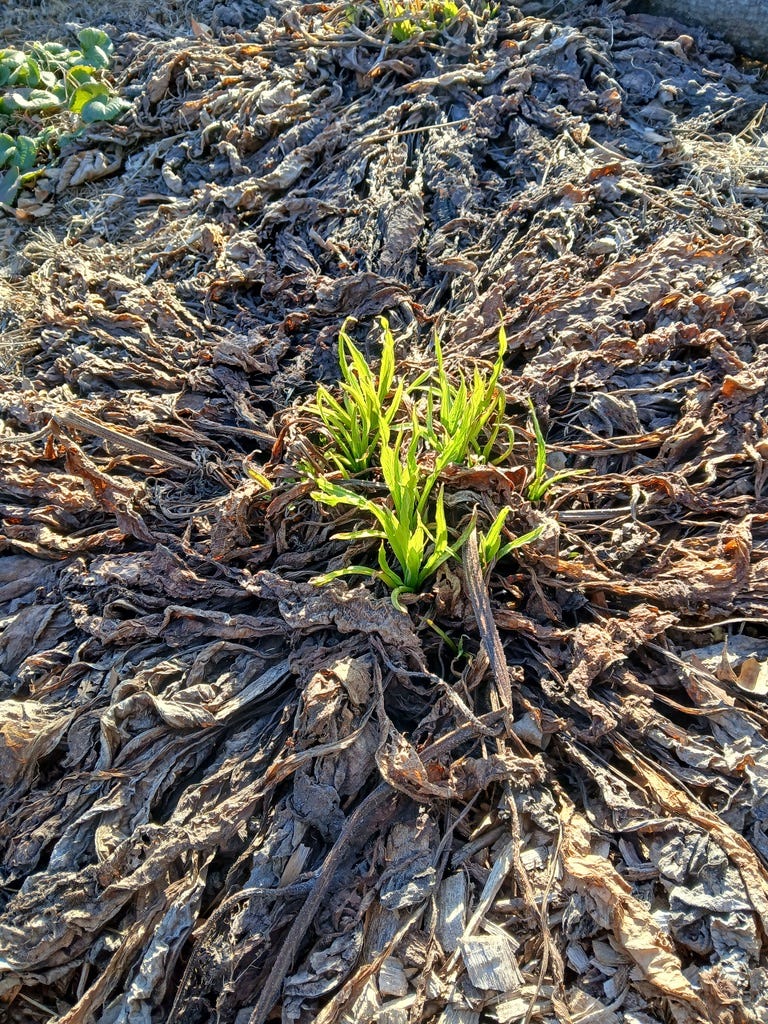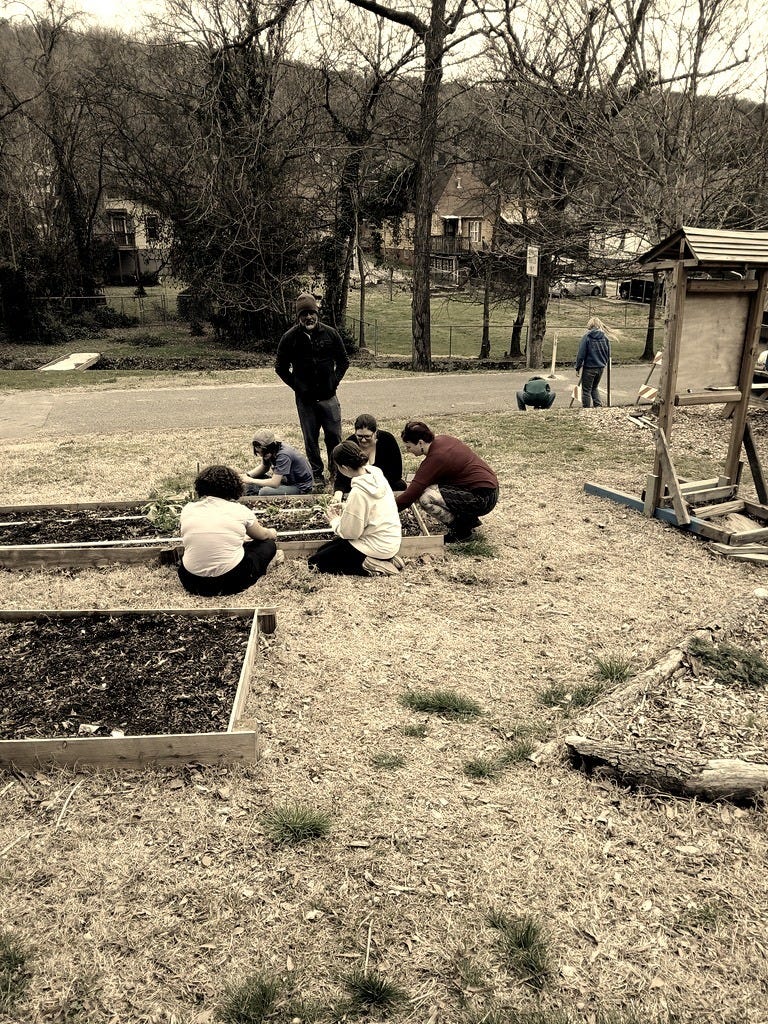More than previous Februaries in recent years this one was for the most part quite wintery; as I write now at the beginning of March winter is lingering on the air a bit longer, though the forecast promises true warm weather in a few days’ time. The trees are waking up, a little more every day or so; the quince, like the one below next to the Westside Greenhouse, have now been blooming for a couple of weeks, seemingly effortlessly resilient against the remnants of winter. Other fruit trees have begun to burst into bloom, especially in sheltered microclimates, just this week. Ephemerals and early blooming weedy plants began to appear mid-month, and now many places around town are festooned with the purple of henbit or the delicate nodding white of shepherd’s purse; at the margins of our Emma Wheeler Homes site little spring beauties are bursting into bloom. Comfrey has begun to push leaves up out of its spirals of last year’s leaves. Insects have started to appear in earnest just over the last week. Spring is rising into what will soon be a great tide of bloom and growth.
As befits the season, much of our activity this past month was preparatory, both of the land and soil with which we will be working in the coming months and of ourselves. The two go together: at various sites over the past few weeks we have been moving earth, woodchips, logs, sticks, scattering cover crop seeds, pulling weeds, checking on the soil and the trees as they begin to bud out—all activities, to be sure, that prepare for the coming season of growth, but also opportunities to learn, to work on our perceptions and understanding. And because we are doing this as part of an ever expanding network of people, people with particular investments in particular places within our coalition of sites, we are also prepping the social ground as it were, and learning more about how to work together, to cooperate and to understand in a mutually productive way.
To give an idea of this work, instead of detailing all of our activities this last month at every site I’ll just mention two instances: continuing work at St. Elmo, and our first ever community food forester training sessions. The St. Elmo UMC community food forest has been helmed by Denise Shaw, who has done the majority of planning and preparation work, overseen volunteer days, and so forth. We had together planned a volunteer orientation day in the middle of February, originally on site—but I had to be out of town, and Denise came down with the flu, so instead we ended up hosting it on Zoom (if you’d like to see the partial recording, find it here). Besides the continued expansion of the infrastructure we are working to expand the social base of volunteers and users; one of the advantages to the site is that Denise has put together a very clear plan and trajectory into which new participants can plug themselves and contribute in their own time and fashion. Towards that end, the students of the Reconnect Nature School and their teachers spent some time on the site towards the end of the month, exploring what is coming up already, and removing unwanted weeds (after learning what constitutes a weed and why they are not somehow universally bad). We were excited to see just how much the soil quality has improved over the last year—it really is remarkable!
On the last weekend of the month Gabe and Nathan Bankhead, founder of Wild Violet Permaculture, led what will hopefully be the first of many community food forester trainings, held at St. Elmo UMC and Emma Wheeler Homes, during which we covered both the community-building aspects of this work as well as the practical work of soil building and growing plants and trees; both aspects reinforce one another and are equally necessary. Some participants have been involved in the coalition’s work from the start, while others were quite new to it—which provided a good opportunity for people from different parts of the city to meet and exchange ideas, dreams, and solutions for problems that we all face to some degree. We were very fortunate to have Nathaniel with his years of accumulated knowledge and experience as instructor, both in the classroom and out on-site; bringing together the abundant expertise and experience that so many people in and around Chattanooga already have and sharing that knowledge is a key goal of our work, and in the coming months we hope to find more ways to realize that goal.
If you’d like to come out and work alongside us and other gardeners, a good way to get connected with a given site is to visit during one of our scheduled work days. I’m out at Ella Library on Mondays from 5 until 6:30 pm or so; if you’ve got kids this is a good site to check out as kids are our primary audience (and work force!). Either myself or JK Willis—who has started partnering with us as of late, more on that in a future newsletter—will be at Emma Wheeler Homes on Thursdays from 4 to 6 pm. Katie Gass, our education coordinator, will be at the South Chattanooga Community Center food forest (back of the community center) on Tuesdays from 12 to 2 pm and on Thursdays from 9 to 11 am. I’ll be doing rotating site visits as well; the March schedule is: March 6: Ascension Lutheran; March 13: Emma Wheeler; March 20: St. Elmo UMC; March 27: Ascension Lutheran. We may be starting an agroecology field school, primarily for UTC students but open to anyone, at the Westside gardens and greenhouse on Friday afternoons, details once we’ve worked that out. Finally, the next session of our reading group will take place on March 13 (reading guide to follow tomorrow), even if you don’t manage to do all or any of the reading it’s a great opportunity to come out and share a meal and talk and listen.
There are challenges ahead, to put it mildly. This part of the world remains in drought, and the short-term forecast at least is not terribly promising. We are now in our second year of activity as an organization, and the question of how to proceed is paramount right now. The wider political and social situation is probably not the most felicitous for getting such an outfit up and running. Unless this newsletter is your sole source of news (which might not be the worst idea in the world, to be honest) you will know that the United States as a whole is currently in the midst of a rather fraught situation with the new administration and its…activities. The grant that we had been awarded at the end of last year, and which we had anticipated bringing online now, has been indefinitely paused, which means that we will be unable to hire spring and summer interns as originally planned. At the same time, there is a very strong possibility that food prices, especially for fresh fruits and vegetables, are liable to rise over the coming months and years—something that we are well placed to address, and have already begun doing so over the last year albeit at a small and very preliminary scale.
As is often the case, the disorientation and disarray that mark our current political moment both build upon and throw into sharper relief long-existing trends and crises. I won’t go into detail—perhaps in a future essay we can explore the intersection of these trends and crises with our work in community agroecology—but suffice to say we are working at the ground level, literally and metaphorically, where so many of the problems our wider society faces are both manifest and where they are causally rooted. I’m not going to pretend that things are otherwise than they are: it’s pretty bleak out there, y’all (see this recent article for some insights—the author’s focus is rural West Virginia but virtually all of it applies to other areas, including our own, mutatis mutandis). The situation is not impossible, but it is certainly hard.
But what makes sense? Asking for a lifeline without context is akin to asking for a key in a hotel with endless floors and rooms; the key is only as valuable as its potential. I hope to continue using this metaphor to help you find the right floor. There will be more questions than answers, but you’ll know which questions to ask and where to find those answers. While there are hundreds of books to tell you about square-foot gardening, raised bed gardens, straw bale gardening, food forests, and more, these prescriptive solutions leave little to tether the gardener to the context of their garden– the landscape and greater ecosystem around them, nor does it contextualize why and how the landscape once fed people for thousands of years.
To restore that relationship with the landscape, we will have to look beyond the borders of our property lines and reconsider what it means to grow food within a greater context alongside our friends and neighbors. If our ancestors grew food alongside the ecology and in the community, what lessons can we learn from those hard-learned practices and incorporate them into the way we grow food today?
Read more: Homesteading with a Planet on Fire: The role of hobby farming in a greater agricultural context
Finally:
After winter has painted her muted, grey colors upon the land, even false spring is full of life and the promise that can be found if one pays attention. Here, it is found in the lavender blooms of henbit and the flowing sap of pecan trees from sapsucker wells. Such inspired promise has been known to turn the wheels of the human mind throughout the ages, and from that, who knows what can happen?






